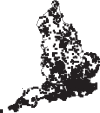Impacts of neonicotinoid use on long-term population changes in wild bees in England
- PMID: 27529661
- PMCID: PMC4990702
- DOI: 10.1038/ncomms12459
Impacts of neonicotinoid use on long-term population changes in wild bees in England
Abstract
Wild bee declines have been ascribed in part to neonicotinoid insecticides. While short-term laboratory studies on commercially bred species (principally honeybees and bumblebees) have identified sub-lethal effects, there is no strong evidence linking these insecticides to losses of the majority of wild bee species. We relate 18 years of UK national wild bee distribution data for 62 species to amounts of neonicotinoid use in oilseed rape. Using a multi-species dynamic Bayesian occupancy analysis, we find evidence of increased population extinction rates in response to neonicotinoid seed treatment use on oilseed rape. Species foraging on oilseed rape benefit from the cover of this crop, but were on average three times more negatively affected by exposure to neonicotinoids than non-crop foragers. Our results suggest that sub-lethal effects of neonicotinoids could scale up to cause losses of bee biodiversity. Restrictions on neonicotinoid use may reduce population declines.
Conflict of interest statement
R.F.P., J.M.B. and B.A.W. are currently funded by Syngenta and Bayer CropScience to perform a large-scale field study investigating the impacts of neonicotinoid insecticides on honeybees. This research presented in this paper was not funded by either company, nor were they consulted about this analysis and interpretation.
Figures




References
-
- Gallai N., Salles J., Settele J. & Vaissière B. E. Economic valuation of the vulnerability of world agriculture confronted to pollinator decline. Ecol. Econ. 68, 810–821 (2009).
-
- Garibaldi L. A. et al. Wild pollinators enhance fruit set of crops regardless of honey bee abundance. Science 339, 1608–1611 (2013). - PubMed
-
- Potts S. G. et al. Global pollinator declines: trends, impacts and drivers. Trends Ecol. Evol. 25, 345–353 (2010). - PubMed
-
- Biesmeijer J. C. et al. Parallel declines in pollinators and insect-pollinated plants in Britain and the Netherlands. Science 313, 351–354 (2006). - PubMed
-
- Goulson D., Lye G. C. & Darvill B. Decline and conservation of bumble bees. Annu. Rev. Entomol. 53, 191–208 (2008). - PubMed
Publication types
MeSH terms
Substances
LinkOut - more resources
Full Text Sources
Other Literature Sources
Molecular Biology Databases

